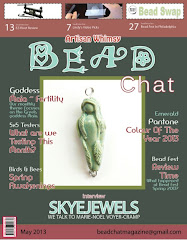Well, blending colors with powdered enamels is almost as easy as it was with our crayons. There are really only few basic caveats to remember:
- when blending with opaques, the opaque coat(s) must go on first. Opaque colors will completely cover whatever color is already there - so you cannot blend 2 opaques, or put an opaque on top of a transparent.
- the number of coats you use makes a huge difference! 1 base of opaque vs. 2, or 1 coat of transparent vs. 2 - the more coats you use, the more intense the resulting color.
- the order in which you blend the colors, when mixing transparents, will also make a difference in the final resulting color
When I started working with Thompson enamels, I quickly discovered that the color of the powder itself isn't always the color you get after firing. Sometimes it's close, and sometimes it's ... not.
The first thing I decided to do was create a "color library" for myself. I set out to fire one or two "test" beads, in every color I had, and every blend I experimented with, because there was no way I could ever remember what the different colors were unless I had these beads as reference. (this is also a good place to put those "bad beads" that just don't behave in the flame - chipping, peeling, bubbling enamel? Fine for the color library!)
I use Craft Mates storage boxes for my color library:
I have seen various systems others use, but this is what works for me - the boxes have individual compartments for each color, with room on the lid for labeling. (Other plastic storage containers can allow the beads to shift from one compartment to another if the boxes wind up upside down - and that would be the end of my library!) The boxes are semi-transparent, so when I am looking for a family of colors, I can easily find the right box. (I try to keep the reds in one box, the blues in another, etc.)
I started out playing with color blending for fun, and was a little intimidated by it. Then, while participating in the Bead Soup Blog Party, I decided to make a kumihimo lariat from gemstone chips:
I planned to sort the chips by color, and braid individual segments of the kumihimo with each separate gemstone. As I planned this lariat, I realized that everywhere I changed colors, the braid would show a visible knot, so I needed something to cover these knots, and large-hole (3mm) metal spacers beads were perfect. Then I got the idea to enamel the metal beads to match the gemstones.
Consulting my color library, I found that iris purple was a perfect match for the amethyst chips, but none of the other colors I had worked on their own, so I was going to have to start blending.
For each individual gemstone, I consulted my color library, picked 2 colors that seemed closest to the color I was trying to make, and fired up the torch! Rest assured, I went through a LOT of trial and error before I settled on the combinations that worked - for the citrine color alone, I tested about 12 different color combos (storing all the rejects in my color library for later reference; someday I might need that color!)
For example, to create peridot-colored enameled beads, I ultimately chose spruce and egg yellow (transparent):
Yellow plus blue makes green, right? The spruce has some green in it, and the addition of the egg yellow brought out the nice peridot green I was looking for. One coat of egg yellow didn't quite get me there, but 2 was perfect! (Note: the egg yellow is transparent, and the spruce is opaque, so the opaque coat must go on first.)
The blue topaz was interesting - here is what finally worked:
2 coats of aqua transparent as a base, with one coat of transparent turquoise on top.
I first tried the reverse: 2 coats of transparent turquoise as a base, with one coat of aqua transparent on top, and it gave a different shade of blue that didn't match the blue topaz, so don't be afraid to play around with your combos. Since both these colors were transparent, either one worked as a base coat, blending-wise, but only one combination gave the result I wanted. Fickle, right?
Citrine was the most difficult for me. After many trials that didn't quite get me there, I got very close with this combo:
A base coat of pumpkin (opaque), with 2 coats of nut (transparent) on top. Just one coat of pumpkin, because 2 coats made the final color too orangy. The resulting bead was a golden yellow, and very close to citrine, but it needed to be a tad more yellow.
So I decided to add a coat of egg yellow on top:
It actually took 2 coats of egg yellow to perfect the citrine I was looking for, meaning this color combo had a total of 5 coats. Without getting to deeply into this topic, suffice to say that 5 coats of enamel on a bead with a 3 mm hole is no problem at all - the hole is plenty large enough to tolerate being narrowed by 5 coats of enamel!
Here are my final blended beads, resting amongst their respective gemstone chips:
Whereas I used to be intimidated to blend colors, this project forced me to step up my blending skills, and now I blend all the time! Blending is a lot of fun, but may involve a lot of trial and error - don't fear the blending! You may create some gorgeous colors on your way to that mystical color you are seeking!

















1 comment:
wonderful love the kumihimo with chips the enamel blending is superb
Post a Comment